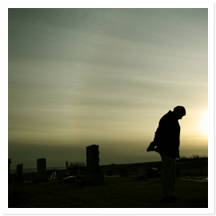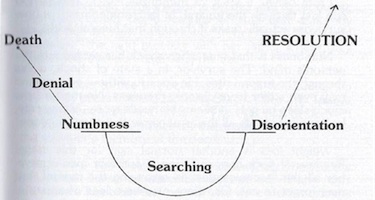 Death is a beginning. Once it occurs the survivor must move on with life, start over. However, there is at first a downward trend after the death occurs, and the survivor will move through four stages of grief before a resolution happens. Some, or even all, of these stages may last from only a few seconds to several months. The point is that each stage will occur, and in a specific order.
Death is a beginning. Once it occurs the survivor must move on with life, start over. However, there is at first a downward trend after the death occurs, and the survivor will move through four stages of grief before a resolution happens. Some, or even all, of these stages may last from only a few seconds to several months. The point is that each stage will occur, and in a specific order.
The stages of grief are illustrated in the graph below. Notice that death is the beginning. From death, a downward pull occurs. Denial happens, followed by numbness. Next, a slump or a feeling of falling into a “pit” when the survivor is searching for answers occurs. As the survivor surfaces from the pit, he enters a disorientation mode but from (his resolutions occur. The arrow at the end of the graph is higher than the starting point, and seems to be going into infinity. The reason for this is that the survivor’s resolve should be at a higher point than pre-death and should be limitless.

The Stages Of Grief
DENIAL
Everyone knows what it means to deny the existence of something. You simply say it isn’t so. But can you explain the difference between denial and avoidance? Here is an example that will illustrate this difference:
Two brothers walk into the funeral home to pay their final respects to their father. Joe looks at the room, the mourners, their father in the casket, and thinks to himself: “Oh, my God. This can’t be true.” Dan looks at the room, the mourners, their father, and thinks to himself as he leaves: “It ¡s true, but I’m not going to think about it.”
Joe denies the death. Even though his father is lying there in a casket, he still denies the death. Joe is going through the first stage of grief. His denial is normal even when he can see his father is dead. Dan, on the other hand, accepts the death but wishes to avoid the reality of it at the moment. Dan’s behavior is also normal, but should not continue for a long period of time either.
NUMBNESS
From denial, a stage of numbness is felt. This period can last through the funeral. In fact, sometimes it is how survivors actually make it through that funeral week.
Numbness is that time when shock has settled into the person’s mind. The survivor, in a state of shock, walks through the funeral rites. He does so without energy, and may even suffer from chronic tiredness. No matter how much sleep he gets, it seems he needs more. At any rate, he continues to do all the arrangements without thinking.
Weight loss is another normal sign for this stage. Because of poor concentration, a survivor may remember all the “technicalities” in arranging the funeral, but may forget to eat. Or, there may be a loss of appetite. After all, what difference does it make if the survivor eats? Who cares?
SEARCHING
It is this kind of questioning that leads us to the next stage of grief: searching. The survivor falls into a kind of “pit.” It is a depressed state that the survivor finds himself in. He questions his own validity, has self doubts, and feels guilt and anger.
When May’s father died she felt many emotions, but the strongest were guilt and anger. She felt guilty because she had a disagreement about the use of the car with him the night before he died. She was angry at him as well, because he had died before their disagreement could be resolved.
May was sure that is she had been able to apologize, he would have died happy, or he would not have died at all. Although their disagreement had nothing to do with his death, May felt guilty that in some way it had pushed him over the edge.
May must work through her guilt, but understand that working through it means she is on her way to recovery. She can correct these feelings of guilt and anger by playing out the next conversation in her head. May could “visualize” the next meeting with her father where they resoIve the question regarding the car.
Being able to see the deceased in this way brings up two other areas in the Searching Stage. They are: Image of the Deceased and Deism. The first has to do with survivor’s ability to accept the death; the second with survivor’s memory of the deceased.
Survivors may dream about a deceased, and the dreams reveal how the survivors accept the death. Our experience has been that people who have violent dreams about the deceased have difficulty accepting the death; whereas, people who have passive dreams have the tendency to accept the death. Their image of the deceased is important in their acceptance.
John had only high praise for his mother after her death. She was good, kind, intelligent, witty, understanding, loving and perfect. Too perfect. John had elevated his mother to God-like stature. It is a common reaction in the searching stage. Often this deism occurs, and no matter what anyone else says, the loved one was a saint. When a person can finally admit that this saint had a not-so-perfect record, then this false deification will end.
Another element of the searching stage deals with loving again. Many times a widow or widower will make the statement that he will never marry again because the spouse could never be replaced, or he will never allow himself to be vulnerable again. After all, if he doesn’t allow love to enter his life again, he cannot be hurt. It follows, then, that if he wants to escape grieving ever again, he simply needs to not love anyone again. Only those people who love can grieve; and, although grieving is not something a person looks forward to, it is better than the alternative: never loving. Grief must become an acceptable and normal part of life and recovery.
Finally, the survivor can begin to climb from the pit to a no less complicated but necessary stage called disorientation.
DISORIENTATION
A rubber band can be pulled in two opposing ways at the same time, but it also does not move from its original position. The pulls and tugs can stretch the rubber band, but they can also restrict the rubber band. Our emotions are like the rubber band after a death. Part of us pulls to move ahead without the loved one, and part of us pulls toward the past because that is the only way we can think of the deceased. We are pulled two ways, but we not move. We are, in fact, restricted in our movement because of this action.
In the Disorientation stage, there are feelings of confusion, worthlessness, self-accusation and loneliness.
When a spouse or child dies, there is often a feeling of: “Why bother going ahead?” But it is the ‘going ahead’ that is very important to recovery and eventually resolution. If a person doesn’t go on with his life, he could slip into a pathological depression and become suicidal. It is especially true in the elderly.
Many times with the elderly, when a spouse dies, it is common to see the survivor die within a short period of time. Can this “willing” one’s self to die be considered a form of suicide?
So, it is with great resolve, or determination, that the survivor must look ahead and stretch forward. The past should not be forgotten, nor should it be lived in exclusively or permanently. Reminiscences are fine, but do not dwell in the past. Let go of the past and watch yourself shoot forward.
RESOLUTION
It is in letting go that resolution can occur. If you do not let go, you will not change, forgive, or understand yourself. The survivor needs to set goals to bring about these areas of letting go. Here is an example of how a simple change can be a very dramatic statement for letting go:
Charles never grew a beard, or mustache, because his wife did not like beards or facial hair. It was not an issue with them, just a fact. When Gwen died suddenly at age 38, Charles found that he was depressed and sought help. After seeing his therapist for a few months, he decided he could face the world without Gwen. His therapist asked him to return in a year, just to keep in touch.
Ten months passed and Charles returned. When he walked into the office, the therapist knew he had let go and was on his way to recovery. Charles had grown a beard.
Through a small action such as growing a beard, Charles had let go. He had not done it rashly or promiscuously, but after a period of adjustment and grief.
It is important to point out that change should not be too hasty, nor goals too lofty. In the beginning it is important to take one day at a time. You don’t want to feel guilty in this final stage of grief. You want to feel good about yourself and your recovery. Here is another example that will help to illustrate when a survivor knows he has come through that final stage of grief:
Jean had been married 31 years when her husband died. On the anniversary of his death she said: “The best piece of advice I received after Eric’s death was to not change anything for a year. Now I am ready to retire and take the trips we had planned to do together.”
Jean has the resolve and will let go.
EXERCISE
1. Pretend to have a conversation with your loved one concerning an unresolved issue. Now you can resolve it.
2. Write a letter to the loved one telling him how you are moving forward with your life.
3. What simple, seemingly unimportant change could you make that would show you are letting go, or have let go?
Canine, J. D. (1990) I Can I Will: Maximum Living Bereavement Support Group Guide. Birmingham, Michigan. Ball Publishers.
